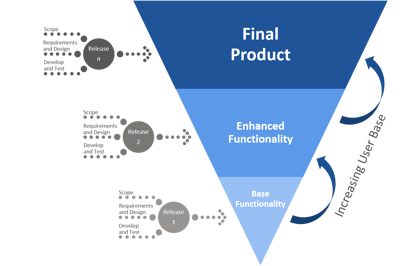
There’s something that intrigues me about tech firms; and it’s not the foosball tables or dog-friendly offices. Tech firms are able to innovate and roll out change at an alarming pace compared to the asset management industry. This is probably the single biggest reason I got sucked into watching Silicon Valley on HBO.
Season 1 of the show opens with an episode called “Minimum Viable Product”. This refers to a product development strategy that provides just enough functionality to satisfy early adopters while also providing a feedback loop for future product development. The secret behind this strategy comes down to a few key items I discuss later in this article. 
The approach to the right looks like a typical Agile project with multiple releases, each delivering incremental functionality. However, I believe firms can benefit from six fundamental tenets behind this approach without adopting a complete Agile framework for project and initiative management.
Stay Focused.
Narrow in on the most important problem that you want to solve. Deconstruct the problem into small manageable pieces and stay laser focused on those pieces.
Prioritize, prioritize, prioritize.
Always do the most important things first! Whether it’s sequencing that’s important, or the business benefit gained from the task, make sure you always know what is at the top of your list.
Make a decision!
We’ve mentioned the cost of indecision in previous blogs—and it applies more than ever to how well you execute on projects and initiatives. One of the leading reason for the user community to lose confidence and interest is seeing progress slowed to a crawl by indecision from the leadership team. Make decisions swiftly and confidently.
Fail Fast.
The fast fail principle seeks to quickly determine if solutions are viable in practice before you spend hundreds of hours and thousands of dollars on a solution that is dead on arrival. Move quickly, but carefully, to vet out the merits of ideas (think prototypes, proof of concepts, etc).
Stay lean.
Large project teams spanning multiple business lines often struggle to stay focused, prioritize and make decisions. This opens the door to competing requirements, heated debates and stalemates. Large projects and complex multi-year programs may naturally have this occur, but you’d be surprised how beneficial it is to keep things as lean as possible even in these scenarios.
Ready, set, go!
Make sure the business is ready for the change! We’ve discussed this many times on the Citisoft blog. The success of any initiative is completely dependent on the degree of readiness of the users. Processes need to be well thought out, support models need to be clearly defined, procedures must be established and well documented, and users need to be trained and comfortable with the impending change.
Keep these six fundamentals top of mind as they will provide tangible benefits regardless of what methodology your firm chooses to use. Strive to deliver relevant functionality, at the right time, to the users who need it the most and are ready to fully employ the capabilities you’ve implemented!









Comments